The Annular Eclipse of 14 October 2023
I posted about this a couple of weeks ago (see sidebar, last entry as of now…well until Wolf adds this post to the sidebar right underneath it). This is an event that would be a total solar eclipse…except that the Moon is near the farthest point in its orbit when it happens, so it’s consequently farther away and appears smaller. Too small, in fact, to cover the disk of the Sun. (The fact that the Sun is slightly closer to the Earth in January than it is in July–because of Earth‘s elliptical orbit around the Sun–probably doesn’t play much of a role; in October it ought to be pretty close to its average distance to Earth.)
And yes…I remember a conversation where I begged people to say “the far side of the moon” to mean the side we don’t see. Because that far side isn’t always dark; it’s quite well lit up when we see the new moon; at new moon the side facing us is the actual dark side of the moon.
Well moons don’t get any newer than when there’s a solar eclipse; we literally see exactly none of the lit side of the moon at those times; it’s perfectly back-lit. So this being my third full eclipse (another annular also in Albuquerque back in 2012, and the total eclipse in 2017), I’ve now seen the entire dark side (and this time it’s correct to say it) three times.
Anyway, it seems like I did everything I could to try to sabotage myself without quite succeeding in doing so. I planned to leave before 4 AM, it was 5 AM when I left. I left the camera I intended to use at home (idiot!) but had every other camera including my second choice (ironically a more expensive camera by far). I forgot to charge the batteries…one was dead, one was halfway there and I had trouble finding it. I also forgot to hang a weight off the tripod.
OK so the original plan was to drive to Albuquerque from Colorado Springs. Albuquerque was almost right in the middle of the track for this thing; the eclipse would last the longest and the Moon would almost perfectly center itself on the Sun…my eyeball, the moon, and the Sun would be in a perfect line for a split second. But the late departure meant I had to take more extreme measures.
Refer to the map:

I-25, which comes down from Colorado Springs is the thick line that comes into the frame at the top, just to the right of center. You’ll notice it meanders a bit. Just after entering the eclipse path, it jogs northwest, and gets no further in; finally it reaches Albuquerque.
I decided, because I was running late, to do something desperate. Notice right after I-25 enters the path, there’s a road running southeast from it (US-84). That’s a two lane road with very little traffic, I could get on that and drop down to the east-west road (I-40) then turn west and actually be getting deeper into the zone.
The eclipse was in progress by the time I reached US-84. I got about halfway down I-40 from US-84 to the next diagonal road (which also runs the wrong way!), stopped and set up. This was exit 234 if memory serves, and if you want to follow along on a more sophisticated map.
By the time I set up my equipment, the eclipse was well under way.
The Equipment
OK, let’s see, I had a Canon R5–roughly $3500. A Canon EF 100-400mm f/4.0-5.6 L, roughly $2200. A $250 tripod. And a two dollar filter to dim the sun enough it didn’t roast the electronics in the camera.
Clearly, before next April’s eclipse I will need a better camera.
OK, seriously, the filter is a piece of thin cardboard with a 1×5 inch window in it; the window has the same plastic they use in eclipse glasses. It’s handy for quick looks at the sun…or it can be duct taped over a camera lens (make sure the duct tape covers any part of the lens the filter does not).
And, incidentally, the R5 is arguably the best EOS camera Canon makes right now, though the R3 is better at a number of things. But not for this job. So I guess I have no choice but to improve the filter.
Oh, yeah, I forgot the duct tape. Fortunately gas station convenience stores usually sell it. Not cheap but IneededitrighteffingNOW!
The filter works…but it imparts an orange glow to everything, and the sun gets an orange tinge to it. Well it would if it weren’t blown out in the images. Which is fine, it should look white not orange anyway. (I could conceivably get photographs of sunspots if I didn’t blow out the sun by mistake; I know I did with the same filter on a different camera during the Venus transit of 2012.) In a way the event looked better through regular cheapass eclipse glasses (which I also had with me), because they aren’t obviously glaring orange in areas that ought to be jett black.
Here’s the first picture I took after setting up.
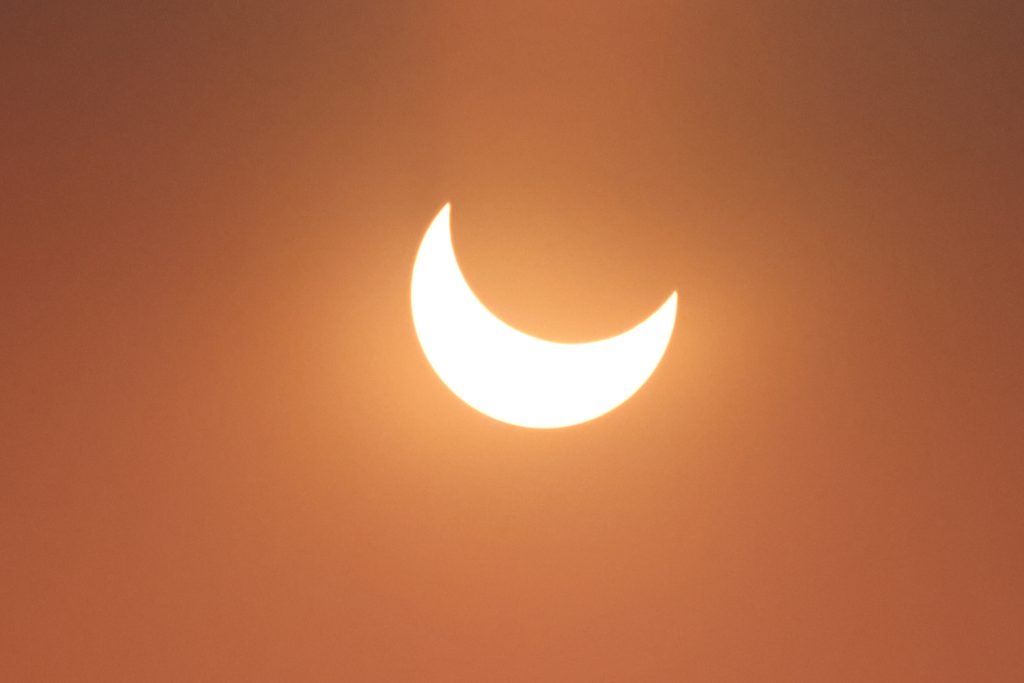
(Cropped from 8192×5464 pixels full frame down to 3000×2000, then reduced in size 50 percent to 1500×1000.)
The Moon came in from about 45 degrees clockwise from the top (1:30 though I shouldn’t use clock positions to indicate directions here because someone might think I am actually giving the time). So given that you can see it has 60 percent of the way across the Sun already. I cut it close!
Closer to annularity:
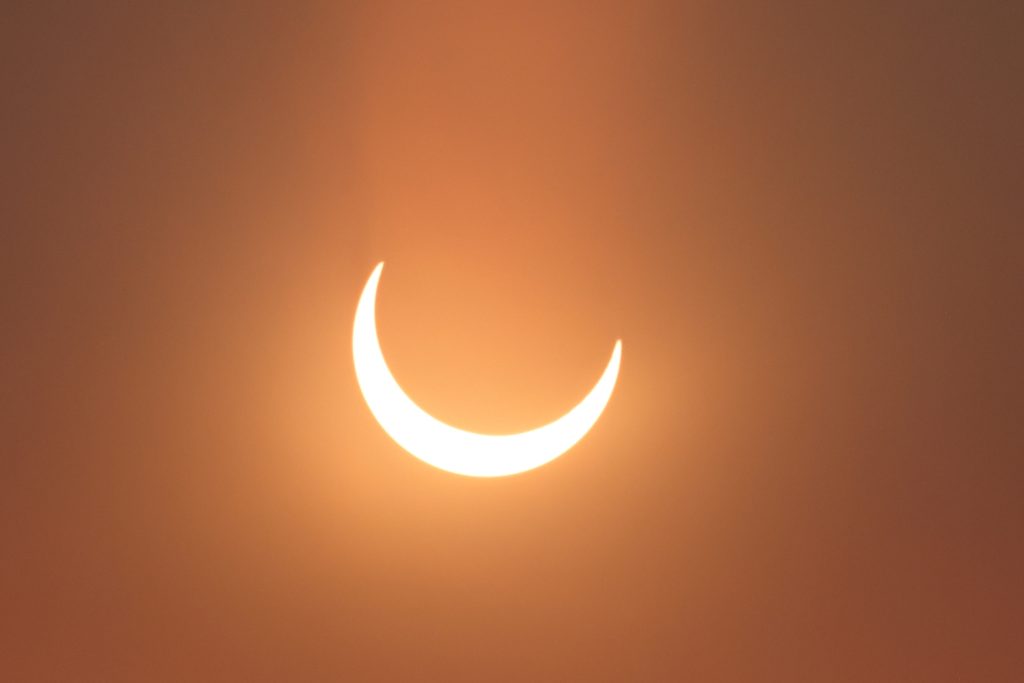
This is right about the point (just a bit later actually) where the crescent of the Sun starts to curve inwards at the tips. That can only happen if the occluding body isn’t as wide (in terms of angle of sky) as the Sun. Or in other words, you won’t see it look like this shortly before a total eclipse.
Getting very close.
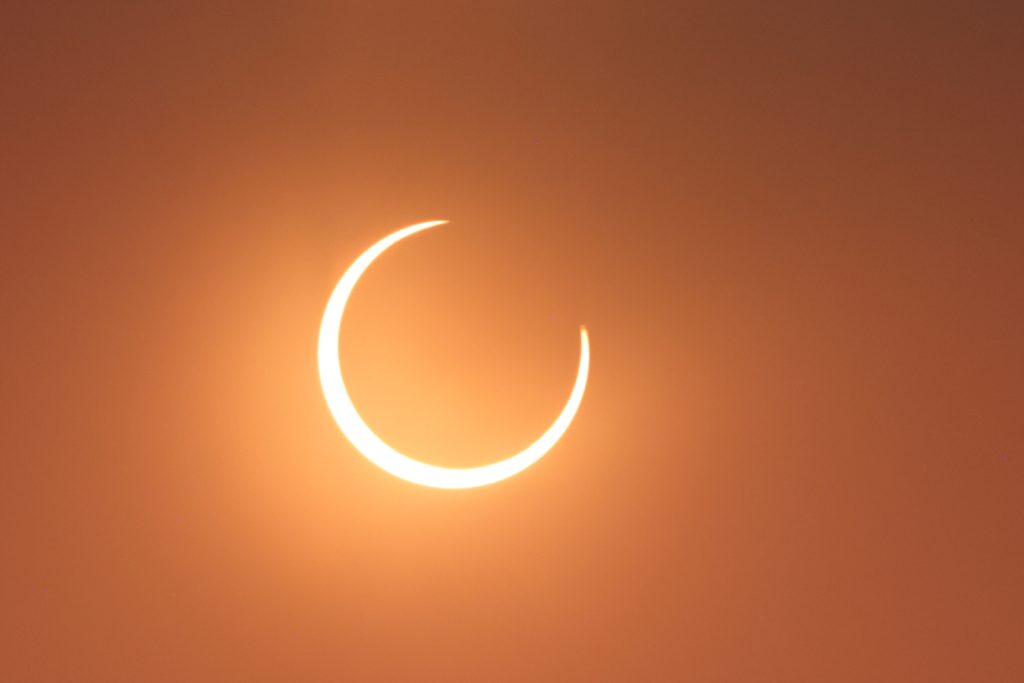
At this point things happen rapidly. I started hitting the button on the bulb (wire remote) every second or so, I can flip through them on my computer and watch the horns of the crescent grow longer. (I want to figure out how to make a time lapse movie out of them. And yes the camera could probably have done that, except I couldn’t remember how to set it up and certainly didn’t have time to do it right there and then!)
Oh, good, I wasn’t imagining things! This is 57 seconds after the previous picture:
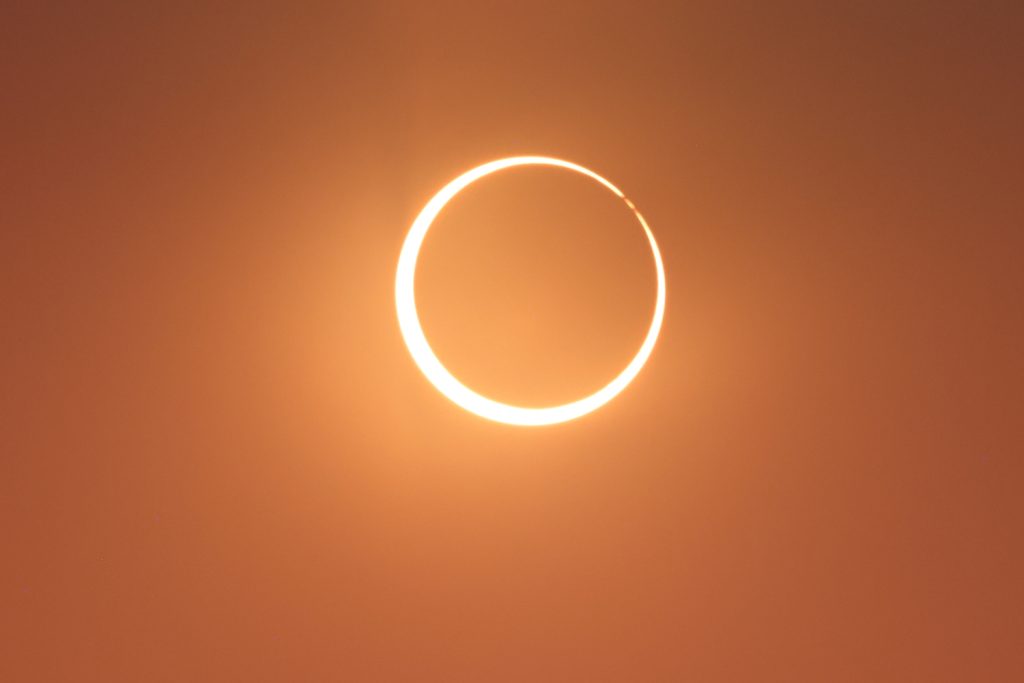
This is the moment right before annularity. The ring is complete…except for two breaks. These are due to mountains on the moon cutting off the Sun’s disk, still…for just that moment. As the moon moves further down and to the left the mounts will eventually fall completely inside the Sun’s disk.
A similar effect happens during a total eclipse but is much more obvious, because the sun shining between the mountain peaks is the ONLY sunlight in view (the rest of the ring is absent). This is called “Bailey’s beads.” Bailey’s beads are visible with the unaided eye and are evidence the moon has mountains and is not an absolutely smooth sphere. (This was controversial around Galileo’s time when many believed everything in the sky was pristine and perfect. Clearly no Chinese weather balloons back then!)
I wasn’t in the middle of the path so the “ring of fire” was not of uniform thickness even at mid eclipse. At roughly 10:38 AM Moutain Daylight Time, this is as close as it came from where I was:
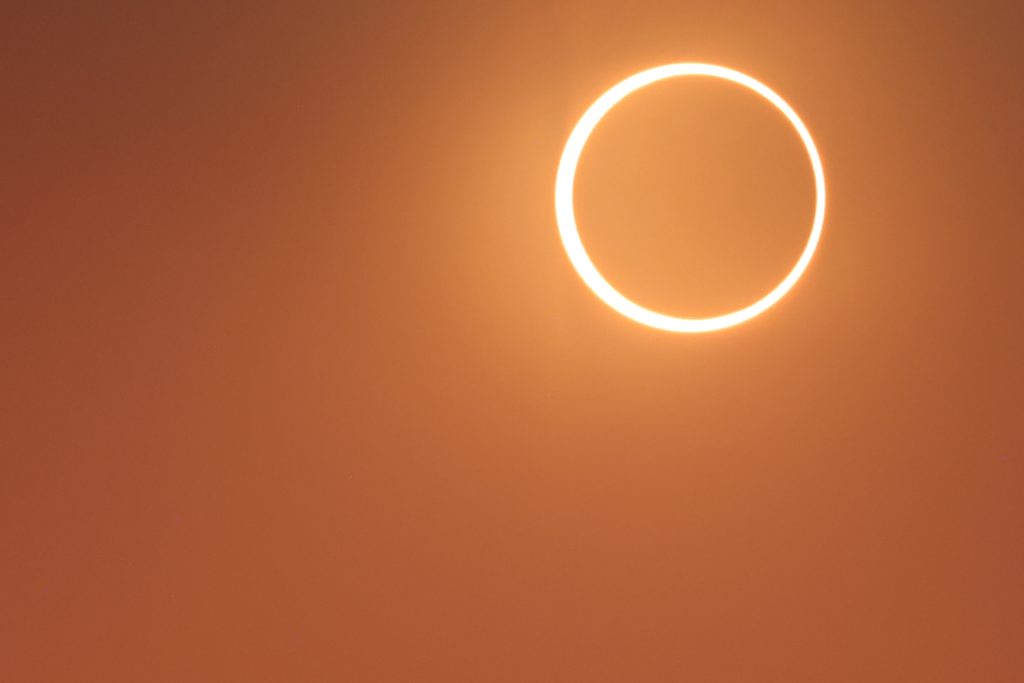
You’ll notice in these last three pictures the sun is apparently moving up and to the right. I didn’t bother trying to center it when I cropped the big 45MP image. Instead I made sure to crop exactly the same area off each picture, so you could see the (apparent) motion of both the Sun and Moon as the eclipse progressed.
Several times I had to loosen the tripod and shift to keep the Sun/Moon from leaving the frame entirely, but I did not have to do that at this time, and so what you see is the real relative motion of the Sun and Moon against the sky as A) the Earth rotates, causing the illusion of motion from east to west, B) the Sun moves, ever so slowly reoughly west to east, taking a full year to completely circule through the entire sky. (That’s what a year is, in fact.) This is “real” motion against the background stars…except for the fact that it’s really us on Earth moving, in the other direction! The Moon is also moving west to east across the sky, about 12-13 times faster than the sun; New Moon is when it laps the sun going across the sky. (And this time it really is the Moon that is moving.)
And now annularity ends.
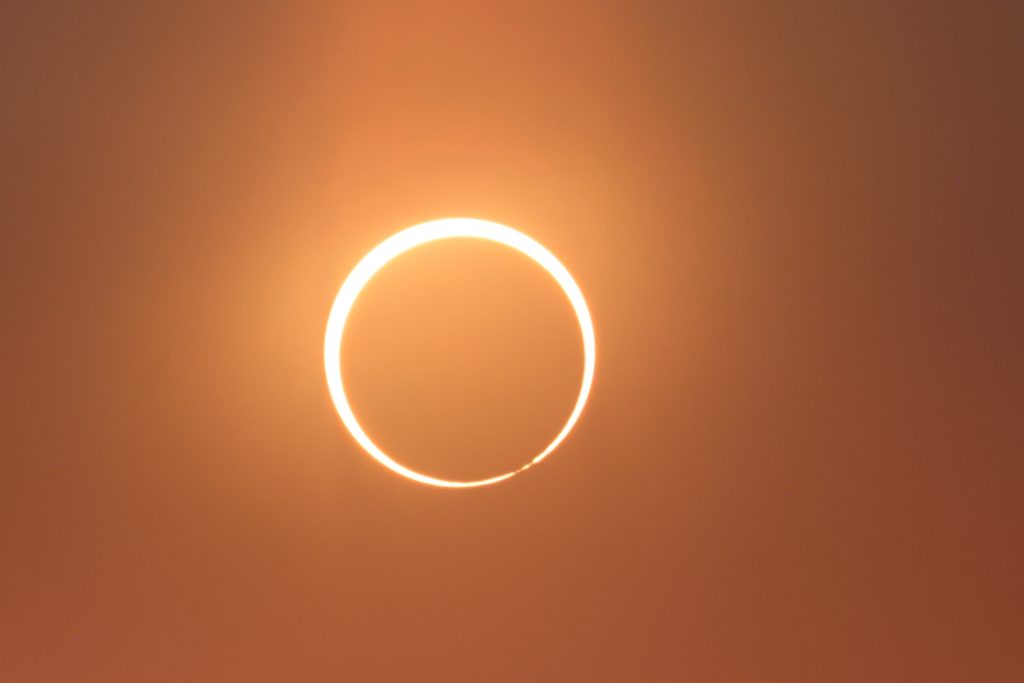
Again, we see the effect of mountains on the lunar rim. People on those mountains, at that moment would see Earth and Sun on the horizon…in two exactly opposite directions. (I did not have to move the camera, but I did crop this from a different location in the frame, so that’s why it seems to be centered again.)
The total duration here, according to the timestamps, is 3 minutes, 49 seconds.
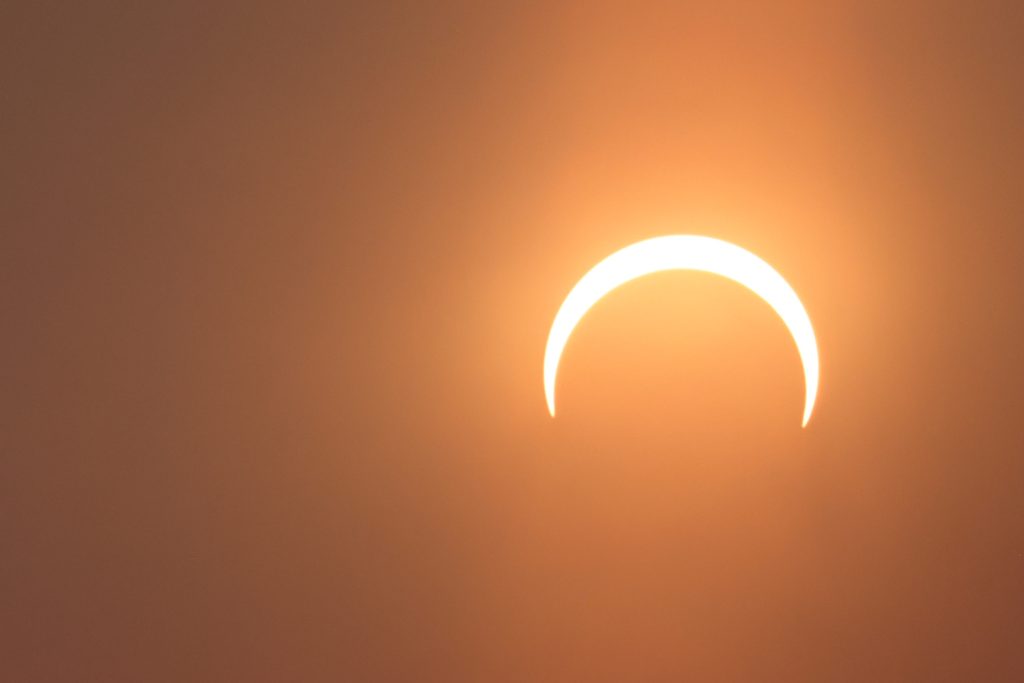
The moon looks like it’s dropping through the center of the bottom side of the Sun. In fact, I joked with another eclipse watcher who was there, that I was now taking pictures of the Turkish flag..which is often hung downwards like a banner (much like the US flag is hung behind the Speaker’s chair in the House of Reprehensibles), with the crescent points towards the ground. Of course the Turkish flag also has a big five pointed star on it.
Last one…the moon almost completely departed, Down and left the tiniest “cut”.
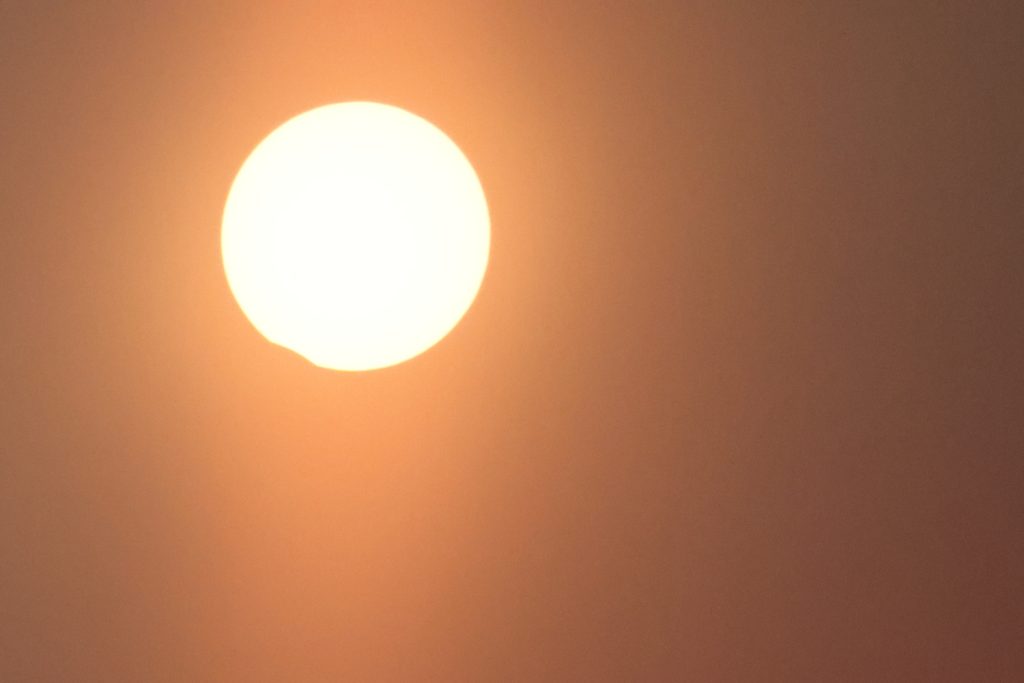
Many lessons learned for next April. Better filter. Dial down the exposure a bit (and maybe catch some sunspots if there are any), and the focus could be a tiny bit sharper.
Until then…










Nicely done. ThanQ.
BTW, one of those pics looks EXACTLY like the muslim crescent.
Uh…yeah. Read the text; I was joking about photographs of the Turkish flag.
Pretty cool, Steve. I forgot all about it until you mentioned it in today’s thread. I’m glad you took pictures.
Me too!
Whoops!
Well done, documenting the event for those of us who weren’t nearby!
&/or forgot &/or had too much cloud cover to see Anything!
I was by no means *nearby* either…4-5 hours of driving flat-out each way. I was pretty much done for when I got home.
That is ‘above and beyond the call of duty’.
Excellent!
Thanks Scott, very cool.
Scott?
It’s an S thing. Happens to me too many times – mixing up the S names.
You’re not the only one who does it.
Mixing up the names I mean.
I read Crime & Punishment once, when pregnant no less, & those Russian names & nicknames were Killer. I Tried to just refer to the starting letter but that wasn’t sufficient w/ so many names/nicknames having similar starting points…sigh…
It’s crazy.
The “middle” name in Russian is actually a patronymic; it indicates your father’s first name (with a change of ending to “ovitch” or something similar).
But there are all these diminutives, like “Sasha” for “Aleksandr”, “Vanya” for “Ivan”, and so on; they’re standard in Russia (no one has any doubt that someone addressed as “Sasha” is “Aleksandr” but non-Russians usually don’t know.
(The interesting thing is those diminutives are feminine in form (ending in -ya or -a) but of course they’re male names.)
The patronymic for females “ovna” iirc. I wonder if there are matronymics in Russian too, albeit rare.
Some Scandinavian countries have, at least historically, had complex parent-onymic names, which makes tracing descendancy down through the ages very difficult. I bet Augergine could elaborate mightily on that topic if she’s ever had to do genealogical research through such naming changes.
A course but inaccurate example would be kids from a father John where the boys’ surnames are Johnson & the girls’ surnames are Johnsdottir. Sons James, John, & Jack would have sons named Jameson, Johnson, & Jackson & similar for their daughters appending -dottir. The sons of John son of John all being surnamed Johnson would make it Appear that Johnson is the family name to the naive or unsuspecting researcher…
An old joke.
A guy is interviewing for a job, and is asked where he went to school.
“Yale.”
The interviewer is impressed, asks a few more questions…and realizes he’s forgotten the man’s name, so he asks, and the man gives his name as Yohnny Yohnson.
LOL
Amazing. TY for sharing your journey with us. Love it!
Could you explain why it looks like the moon is coming in from roughly the 2 o’clock position in the top image but departing from roughly the 12 o’clock position in the bottom picture?
If you end up putting that time lapse video together I hope you share it with us too.
Also, you might want to append a link to This post on the post where you discuss annularity for ease of navigation 🙂
Blessings!
Really the best indicator of where it left is the very last picture, where you can see a tiny flat spot on the sun’s rim, at about 7 o’clock. Which is actually a pretty close match for what you see in the first picture I took.
What I need to do is to practice photographing the sun on a normal day. The more I look at these pictures, the less happy I am with them from a technical standpoint. They’re simply blown out. I should be able to see sunspots (if any are there to be seen); I know I couldn’t possibly see them with these pics (not just that I don’t see any, but that I couldn’t see them even if they were there).
But I need to buy the real, non $2, filter before I do that.
Thx 🙂 I have Zero quibbles with your technical expertise since this arena is way outside my wheelhouse. It’s great that you got this somewhat hiccuppy dry run to prepare for the real eclipse. I hope when that happens you get easy access to a good viewing spot w/ no weather interference!
My husband is the family photographer. He even took classes in HS or college, I forget which, darkrooms, chemicals, drying, & all 🙂
Oh, I mean it’s hard to tell where it’s going to leave that early, but that last picture is exactly the moment the moon did completely uncover the sun, so it’s ideal for determining the exit direction. And it matched pretty well.
Another issue, too, is that the camera is tilted with respect to the plane of the ecliptic, AND that tilt will change through the day, so it’s not going to even look consistent. THAT…I can’t figure out how to explain in words right off the top of my head but I can try to give you a hint. Imagine taking a picture of the moonrise. Your camera will probably be oriented long-side horizontal. But the moon’s path at that moment is at a slant to the horizon, so the path is tilted in the picture. Six hours later when the moon is high up in the sky, but you face south to look at it…the path it’s following will probably be lined up with the long side of your camera.
The way to fix that is with a fancy mount that lets the camera swivel in the plane of the moon’s path…rather than in the horizon plane.
THAT probably made no sense without a diagram. Sorry.
Some sense but I’m pretty addle-brained w/ non-stop special needs chaos w/ Josiah & his wife Rose within a couple feet of me as we’re watching the Detroit Lions game. They often speak non-sensically & sometimes make random (annoying) noises…sigh…It’s a fairly big brain drain for me…AND I need access to All the brain cells I can resurrect to converse with you! 😉 😉
Image of the lit ‘Dark Side’ of the moon during New Moon from the DSCOVR satelliet which is positioned at L1 Lagrange pointing camera towards Earth:
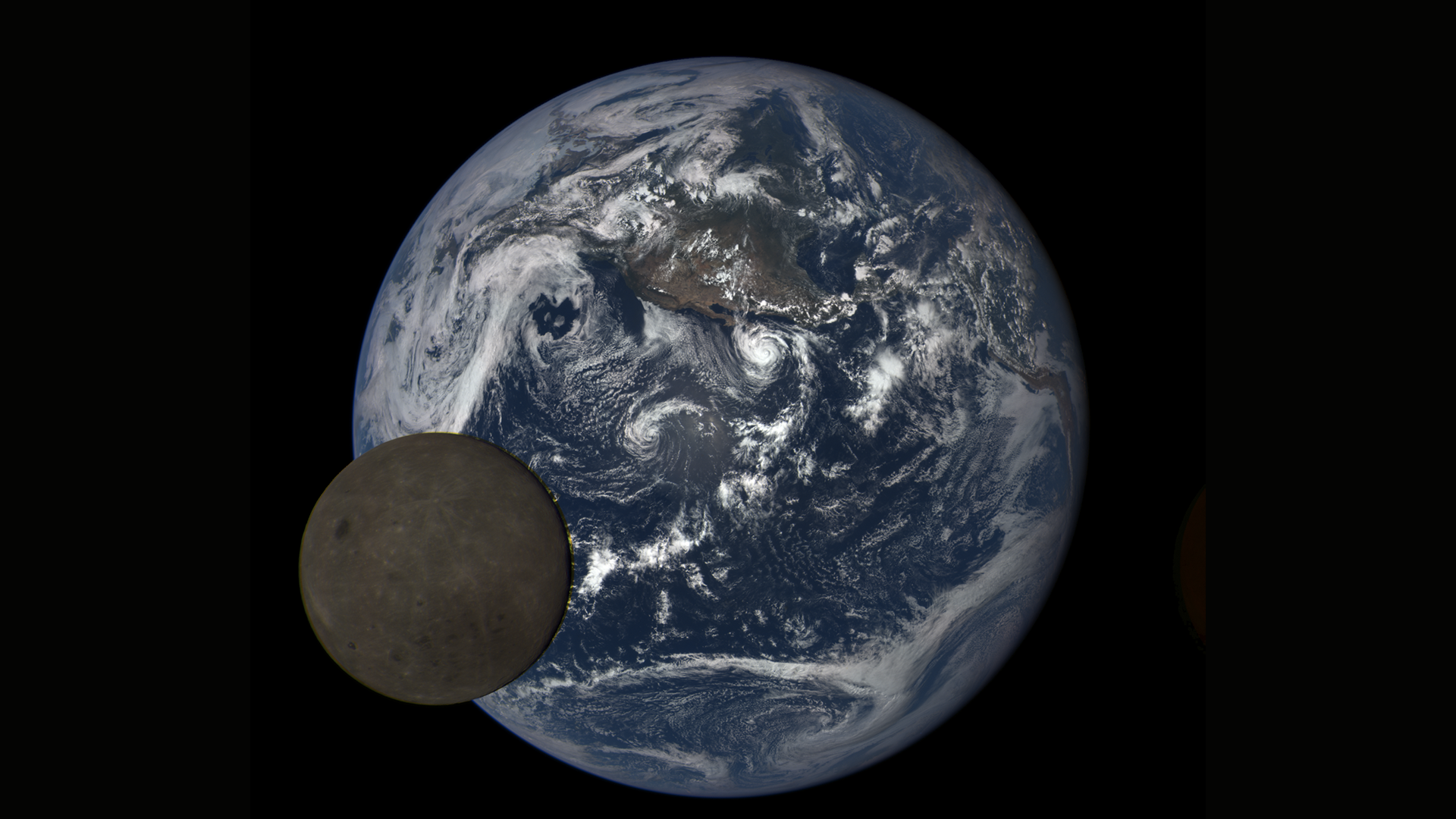
NOAA’s DSCOVR Satellite Celebrates its Sixth Launch-iversary | NESDIS
Very cool. Thank you for sharing that!